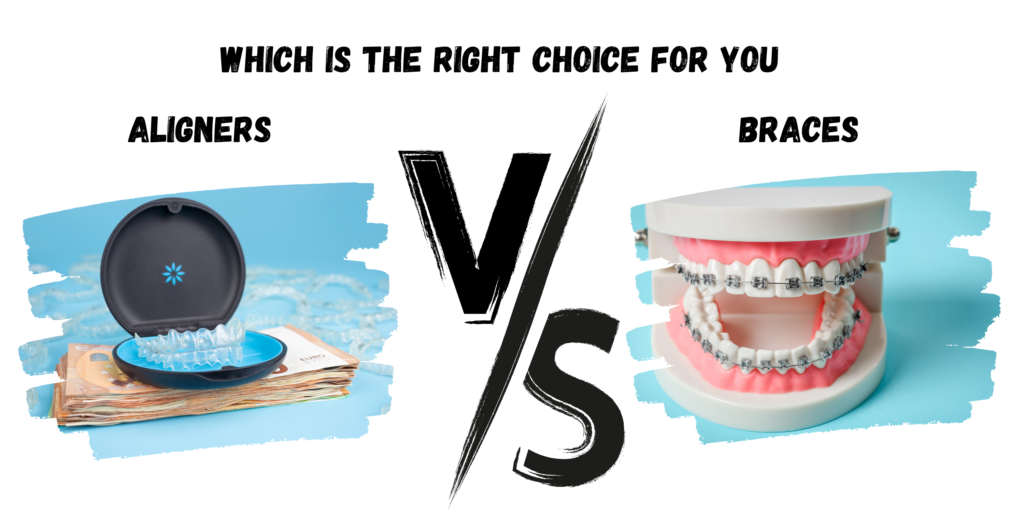Thinking about straightening your teeth but not sure whether to go with aligners or braces? You’re not alone. Choosing the right orthodontic treatment is more than just a cosmetic decision—it can impact your lifestyle, comfort, and even your dental health. Let’s break it down in plain English and help you make the best decision for your smile.
What Are Dental Braces?
Braces are the age-old, reliable method for straightening teeth using brackets, wires, and elastic bands. They apply continuous pressure to slowly shift your teeth into place.
Traditional Metal Braces
These are the most common and effective type of braces. They’re strong and suitable for even the most complex dental issues.
Ceramic Braces
These work like metal braces but blend with your teeth. They’re less visible but a bit more fragile.
Lingual Braces
Attached behind the teeth, lingual braces are hidden from view but can be uncomfortable and tough to clean.
How Braces Work
Braces are bonded to your teeth and adjusted monthly by your orthodontist. They gradually shift your teeth using force and pressure over time.
What Are Clear Aligners?
Aligners, like Invisalign, are a modern alternative. They are transparent trays made of plastic, custom-molded to fit over your teeth.
Popular Brands Like Invisalign
Invisalign, ClearCorrect, and other brands offer customized aligner systems that can treat a wide range of issues.
How Aligners Work
You’ll receive a series of trays—each one moves your teeth slightly more than the last. You wear them for 20–22 hours a day and switch them every couple of weeks.
Customization and Flexibility
Aligners are removable and nearly invisible. That means fewer food restrictions and no emergency wire pokes!
Major Differences Between Aligners and Braces
Appearance
Aligners are virtually invisible, while braces—especially metal—are more noticeable.
Comfort and Irritation
Aligners have smooth edges and less irritation. Braces can cause sores from brackets and wires.
Treatment Duration
Braces typically take 18–24 months. Aligners can be quicker but depend heavily on how disciplined you are in wearing them.
Cost Factors
Braces are usually more affordable in India, starting from ₹25,000. Aligners range from ₹60,000 to ₹1.5 lakh depending on complexity.
Maintenance and Hygiene
Aligners win here. You can take them out while brushing and flossing. Braces need extra care and tools to clean around the wires.
Effectiveness for Complex Cases
Braces are more effective for severe crowding, rotated teeth, or major bite issues.
Pros and Cons of Braces
Pros
- Best for complex issues
- No self-discipline needed to keep them in
- Often cheaper
Cons
- Very visible
- Can be uncomfortable
- Requires frequent dental visits
Pros and Cons of Aligners
Pros
- Nearly invisible
- Removable during meals and brushing
- Fewer dental appointments
Cons
- Costlier
- You need discipline—forgetting to wear them slows progress
- Not ideal for very complex corrections
Factors to Consider Before Choosing
Age and Lifestyle
Teens and adults often prefer aligners for aesthetic reasons. Braces are suitable for kids or anyone needing significant corrections.
Orthodontic Needs
If you have major misalignment, braces might be your only choice.
Budget
Braces are generally more affordable in Indian clinics like Dental Wires Dental Clinic, Panchkula.
Discipline and Commitment
If you think you’ll forget to wear aligners consistently, braces might be safer.
Real-Life Experiences and Testimonials
Stories from Braces Users
“I had braces at 17 and though they were visible, the results were perfect. I now have a confident smile.”
Stories from Aligner Users
“As a working professional, I loved how aligners fit my lifestyle. No one even noticed I was wearing them!”
What Dentists Recommend
The experts at Dental Wires Dental Clinic say:
“Each mouth is different. Come in for a consultation so we can help you pick the best path for your smile journey.”
Common Myths Debunked
Myth: Braces are only for kids
Truth: Adults get braces too—and often achieve faster results due to better compliance.
Myth: Aligners don’t work for major corrections
Truth: Modern aligners can handle moderate to complex cases, though braces still win in extremely severe cases.
Who Should Choose Braces?
- Kids and teens
- Patients with complex misalignment
- Those on a tighter budget
- People who might forget to wear aligners
Who Should Choose Aligners?
- Working professionals
- Adults looking for a discreet option
- People with mild-to-moderate issues
- Anyone ready to commit to wearing them 22 hours daily
Cost Comparison: Aligners vs Braces in India
| Treatment | Average Cost |
| Metal Braces | ₹25,000–₹50,000 |
| Ceramic Braces | ₹35,000–₹70,000 |
| Invisalign/Clear Aligners | ₹60,000–₹1.5 Lakh |
Note: Prices vary by case complexity and location. Always consult a professional.
Tips for Taking Care of Your Orthodontic Device
- For braces: Brush after every meal, use interdental brushes, avoid hard/sticky foods.
- For aligners: Rinse before and after use, clean trays daily, avoid hot water that could warp them.
Conclusion
At the end of the day, whether you choose braces or aligners, you’re investing in a better smile and improved oral health. Aligners offer flexibility and aesthetic appeal, while braces bring unmatched power for complicated cases. Still unsure? Reach out to your orthodontist for a personalized consultation and get ready to smile with confidence!
FAQs
1. Are aligners faster than braces?
In some mild cases, yes. But for more complex issues, braces can be more efficient.
2. Can I switch from braces to aligners mid-treatment?
Yes, but only under the supervision of your orthodontist.
3. Do aligners hurt less than braces?
Most people report less pain and irritation with aligners.
4. Are results permanent with aligners?
Yes—if you wear retainers after treatment, just like with braces.
5. How often do I need to visit the dentist?
Braces need monthly visits. Aligners may need check-ins every 6–8 weeks.
